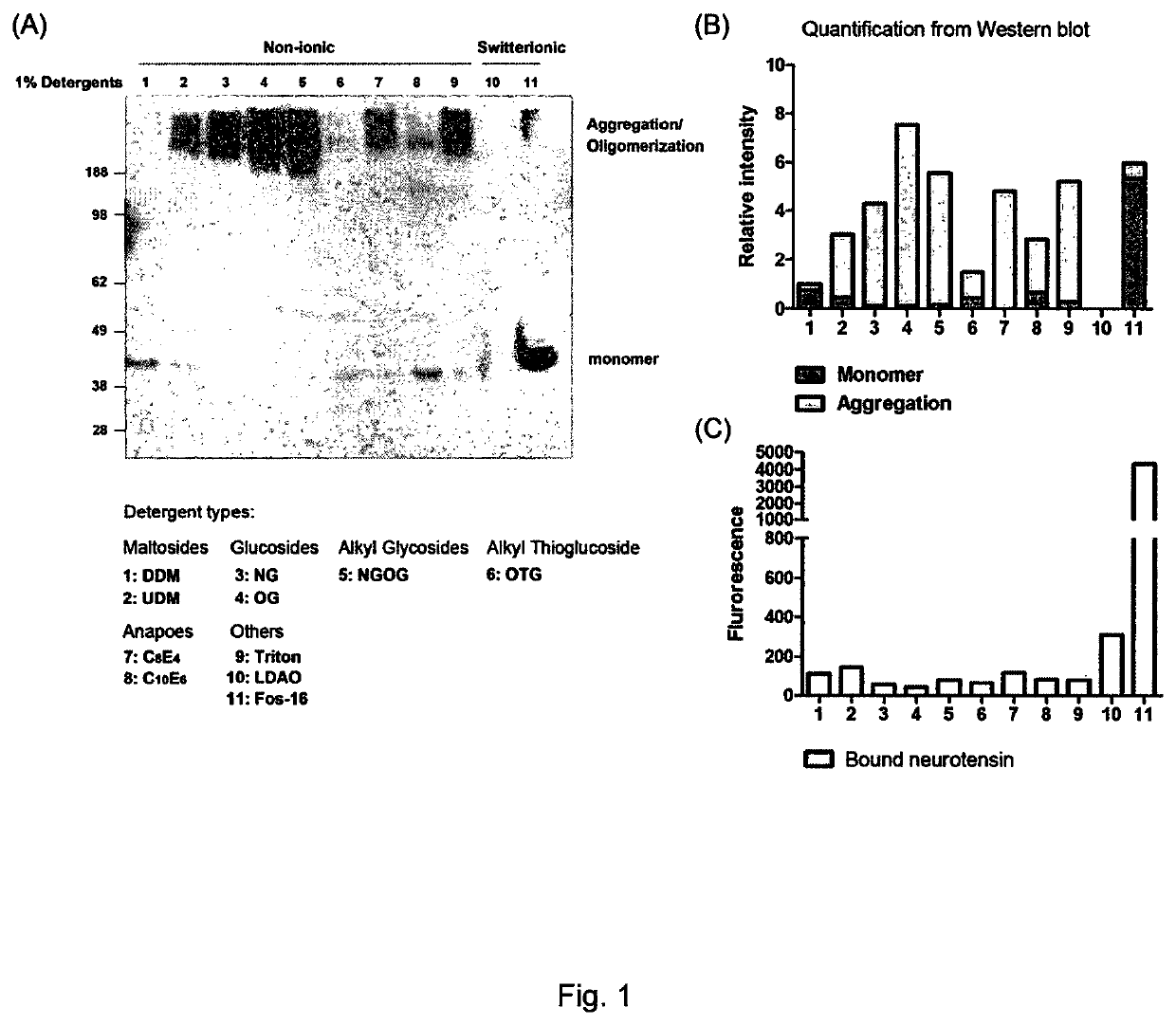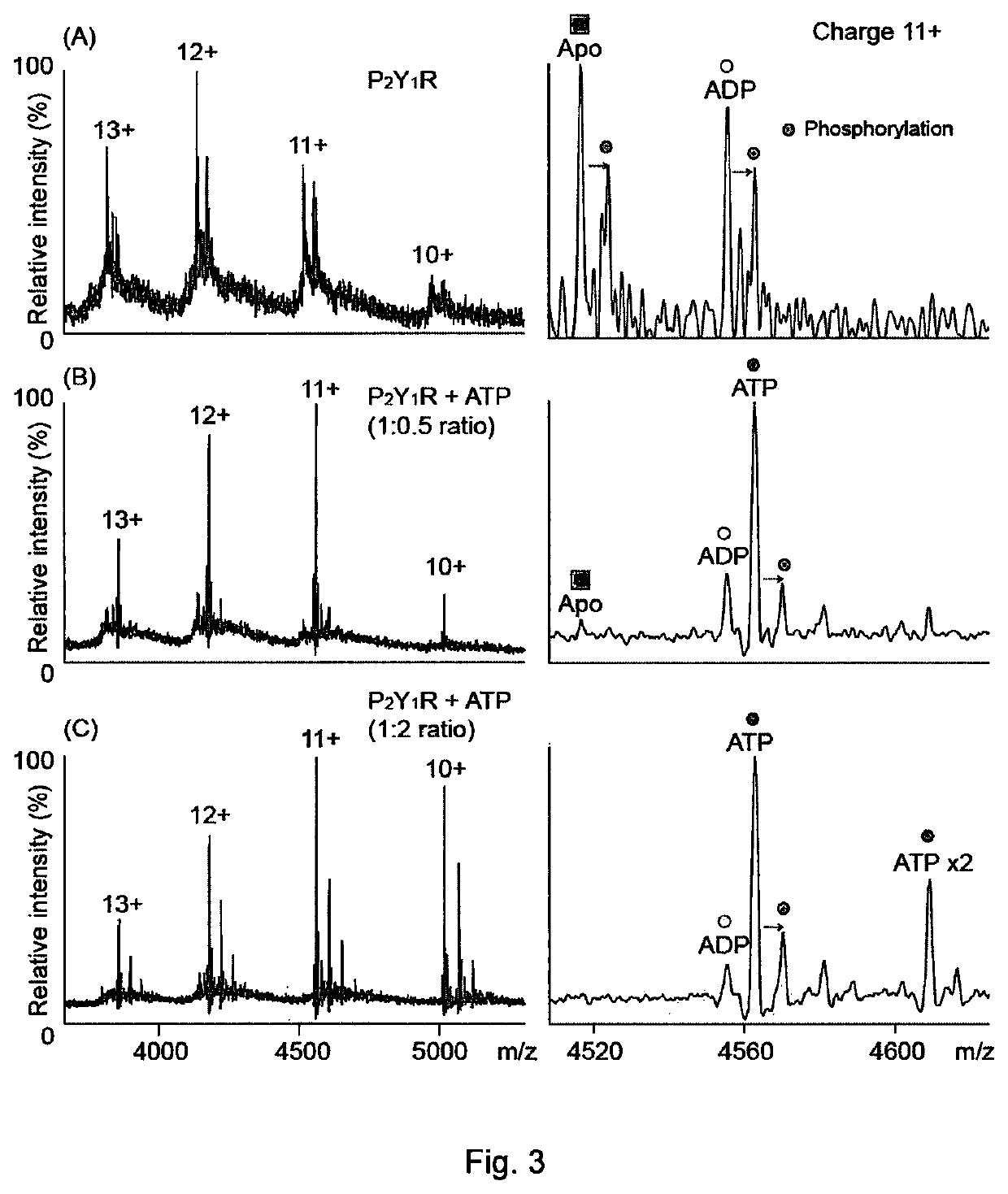Detection of membrane proteins
a membrane protein and protein technology, applied in the field of membrane protein detection, can solve the problems of limiting x-ray analysis, hindering progress, and affecting the study of traditional structural biology approaches, and achieve the effect of reducing receptor aggregation and substantially conserving ligand binding activity
- Summary
- Abstract
- Description
- Claims
- Application Information
AI Technical Summary
Benefits of technology
Problems solved by technology
Method used
Image
Examples
example 1
[0138]Various detergents were assessed for their ability to preserve the conformation and activity of NTR1. The detergents assessed were: (1) n-dodecyl-β-D-maltoside (DDM); (2) n-undecyl-β-D-maltoside (UDM); (3) n-nonyl-β-D-glucopyranoside (NG); (4) n-octyl-β-D-glucopyranoside (OG); (5) octyl glucose neopentyl glycol (OGNG); (6) n-octyl-β-D-thioglucopyranoside (OTG); (7) tetraethylene glycol monooctyl ether (C8E4); (8) hexaethylene glycol monodecyl ether (C10E6); (9) polyethylene glycol tert-octylphenyl ether (Triton X-100); (10) lauryldimethylamine-N-oxide (LDAO); and (11) hexadecylphosphocholine (Fos-Choline-16).
[0139]It can be seen from the results presented in FIG. 1 that the use of a phosphate ester detergent (Fos-Choline-16; detergent 11) is advantageous as compared with the other detergents tested. In more detail, FIGS. 1A and B show that less receptor aggregation and oligomerisation occurred with the phosphate ester detergent than with other detergents. FIG. 10 shows that th...
example 2
[0140]Mass spectrometry was used to study the human P2Y1 purinergic receptor (P2Y1R) and its interactions with nucleotides and a high affinity antagonist, MRS2500. This receptor, a class A GPCR, functions as a receptor for extracellular adenosine 5′-diphosphate (ADP) and adenosine 5′-triphosphate (ATP), and regulates many physiological processes. P2Y1R is fully activated by ADP to facilitate platelet aggregation via calcium wave propagation and thus serves as an important antithrombotic drug target. Inhibition of P2Y1R activation shows significant decrease in ADP-induced platelet aggregation.
[0141]High-resolution MS was used to probe the drug / ligand interactions of human P2Y1R purified from insect cells. By controlled application of collisional activation, intact P2Y1R was liberated from its detergent micelle, preserving the non-covalent interactions formed in solution. The phosphate-containing detergent of Example 1 (Fos-16) was used in these experiments.
[0142]ESI-MS spectra of pur...
example 3
[0147]In a further experiment, mass spectrometry was used to characterise the binding affinity of PIP2 to NTR1. The phosphate-containing detergent of Example 1 (Fos-16) was used in this experiment.
[0148]FIG. 6A shows the measurement of PIP2 binding of NTR1 in a concentration-dependent manner. Multiple binding of PIP2 was observed after incubation of PIP2 and NTR1 in Fos-Choline-16. FIG. 6B depicts the binding kinetics of various PIP2 to NTR1 (upper; PI(4,5)P2; lower: PI(3,4)P2). Binding curves of different number of PIP2 were plotted according to the quantification of MS spectra, allowing calculation of the dissociation constant (Kd).
PUM
| Property | Measurement | Unit |
|---|---|---|
| capillary voltage | aaaaa | aaaaa |
| cone voltage | aaaaa | aaaaa |
| temperature | aaaaa | aaaaa |
Abstract
Description
Claims
Application Information
 Login to view more
Login to view more - R&D Engineer
- R&D Manager
- IP Professional
- Industry Leading Data Capabilities
- Powerful AI technology
- Patent DNA Extraction
Browse by: Latest US Patents, China's latest patents, Technical Efficacy Thesaurus, Application Domain, Technology Topic.
© 2024 PatSnap. All rights reserved.Legal|Privacy policy|Modern Slavery Act Transparency Statement|Sitemap



